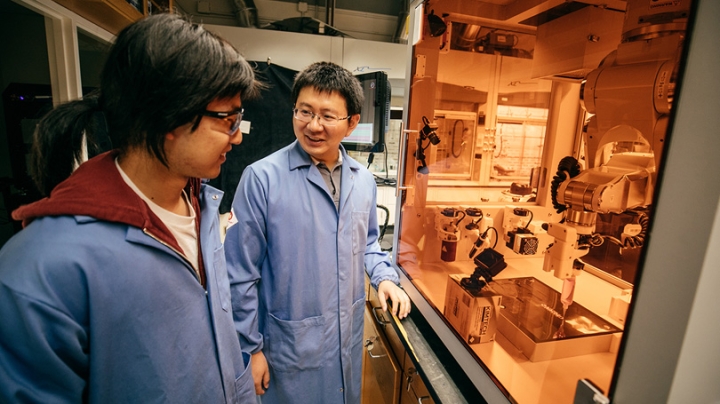Next week, Dartmouth will host one of the first international, interdisciplinary conferences on the future of “additive manufacturing,” the rapidly evolving field of 3D printing using advanced materials to create a spectrum of objects, such as artificial knee tendons, an implantable framework for brain neuron repair, soft-tissue robots, and performance-enhancing sneaker soles.
Assistant Professor of Chemistry Chenfeng Ke, an organizer of the conference, notes a certain kinship between this conference and the 1956 Dartmouth conference at which the term “artificial intelligence” was coined. The AI conference, like the upcoming 3D printing conference, was a gathering of the research community in a field on the cusp of new realms of discovery.
“The AI concept was cultivated here, so yes, in a similar way we want to cultivate some interdisciplinary collaborative thoughts in the area of additive manufacturing—AM,” Ke says. He hopes the symposium can become a regular event held every two years.
The two-day conference, to be held at the Hanover Inn Aug. 12 and 13, brings together researchers and scholars from the fields of chemistry, materials science, computer science, and engineering as well as industry players and entrepreneurs from across the United States, Europe, and Asia for “3D Printing 2019: An Interdisciplinary Additive Manufacturing Symposium.” Participants will look at a range of ideas in the field, including materials development, polymer chemistry, computational tools and models, green 3D printing, and 3D entrepreneurship. The talks and events on Monday afternoon, including a poster session and industry demonstration, are open to the public.
Until now, researchers in mechanical engineering, polymer and materials chemistry, computer science, and related fields have conferred separately to discuss 3D printing research, Ke says.
“There are separate meetings, but they don’t have cross talk, so we wanted to create this meeting to bring people with different expertise together, trying to connect from the very beginning—from the earliest computation and simulation, to the end-part of materials making and engineering,” Ke says.
The biomedical, printing materials, 3D printing technology, and 3D manufacturing industries as well as major publishing houses in the field are co-sponsors of the conference along with Dartmouth. Top scholars and researchers will make presentations at the conference, which will also include panel discussions and opening and closing sessions. In addition to Ke, the conference is co-chaired by Assistant Professor of Computer Science Bo Zhu, Adjunct Assistant Professor of Engineering Jeremy Faludi, and from the University of Texas at Dallas, Associate Professor of Chemistry Ronald Smaldone.
Ke’s own research uses carbohydrate-based printing materials he developed to create a tiny 3D architecture that can exist symbiotically with biological organisms on the cellular level. His lab is developing this material to enable 3D printing of structures such as artificial tissue scaffolds for treatment in traumatic brain injury.
“There are a lot of things you can play with in 3D printing, so that’s why we hope to inspire the different people who have different specialties and try to bring them together,” Ke says.
William Platt can be reached at william.c.platt@dartmouth.edu.
Video | Celebrating Dartmouth’s 250th in 3D

The graduate students in the Ke Laboratory sent a 3D model of the Dartmouth 250 logo to the 3D printer for a special demo. The case for the printer is tinted amber to block ultraviolet light when the printer is used to build bio-compatible structures for use in medical research. The actual printing project took about 40 minutes to complete. (Time-lapse video by Robert Gill)


